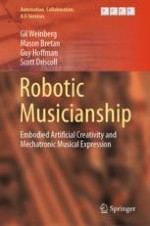2020 | OriginalPaper | Chapter
6. “Watch and Learn”—Computer Vision for Musical Gesture Analysis
Authors : Gil Weinberg, Mason Bretan, Guy Hoffman, Scott Driscoll
Published in: Robotic Musicianship
Publisher: Springer International Publishing
Activate our intelligent search to find suitable subject content or patents.
Select sections of text to find matching patents with Artificial Intelligence. powered by
Select sections of text to find additional relevant content using AI-assisted search. powered by
